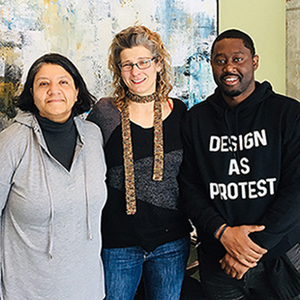Prof Saskia van Kampen (SFSU) and Cheryl Giraudy (OCAD U) receive $25,000 SSHRC Partner Engage Grant for Toronto-based research project.

“Placemaking has the ability to strengthen the connection between people and the places they share” (Project for Public Spaces, 2016).
Design Wo/ManifesT.O. 2020 is a 4+ phase research project that is partnering with New Orleans-based, non-profit, Colloqate Design for a “Creative Practice as Process” (CPP) Workshop and student/NextGen ideas competition that will be funded through an Ontario SSHRC Partnership Engage Grant (PEG). The project asks how innovative methods for placemaking emerge at the community level through creative practice and the social impact of their outcomes. Toronto has experienced massive growth with both positive and challenging outcomes that come with fast-paced urban sprawl including: racial and economic inequity across neighborhoods, gentrification of neighborhoods, a growing schism between left and right political perspectives, ongoing efforts for reconciliation with the indigenous population… From major infrastructure projects in the 1950’s and 60’s to the modernist projects such as New City Hall, and to contentious amalgamation of diverse independent municipalities, we have a zeitgeist of Toronto as a collection of evolving neighborhoods, connected by a transit network that everyone loves to hate. Design Wo/ManifesT.O. 2020 asks what are the future, provocative, and creative interventions for community-based place-making in a dynamic, diverse, and ever growing city such as Toronto?
This participatory action research project has an inclusive design focus, which expands our thinking about accessible environments by considering cultural, ethnic, racial, physical and other diversity. Most importantly, inclusive placemaking must happen from the inside and work out—it must come from the people who will be living and working and playing in those places (Altay, B. & Demirkan, H., 2014).Design Wo/ManifesT.O. 2020 is positioned to understand how each of Toronto’s six boroughs; with their vastly different histories, neighbourhood character, and other qualities, engage in independent placemaking efforts, some well documented, others not as well known, using creative practice as the catalyst.
This is not to be confused with “Creative Placemaking,” which combines the arts in partnership with better endowed federal agencies—“cross-sectoral intergovernmental partnerships for placemaking” (Zitcer, 2018). This type of alignment tends to be economically driven—the impetus being to make the place attractive to visitors rather than supporting the needs of the community. This has the potential to gentrify the neighborhood and for the displacement of residents (Eisinger, 2000)—similar to what is presently happening to Toronto’s Chinatown, Parkdale, and Regent Park neighbourhoods (Nasser, 2019).
Working with Colloqate Design’s founder Bryan C. Lee, professors van Kampen and Giraudy will organize an Ideas Competition where they will engage students in inclusive and respectful design activism activities and prepare them to address one of the issues that they choose from the collected data—actually addressing an issue from participant input. “Design speaks to the potential for equitable spaces and attempts to visually and physically represent our collective aspirations for the future” (colloqate.org/about). Through this partnership we hope to be able to inspire NextGen creative thinkers to build and nurture a society that lives up to what Toronto professes to be: “one of the most multicultural urban areas in the world. Each year tens of thousands of newcomers from around the globe choose our city as their new home. Their diverse cultures and communities have helped create Toronto’s identity as a vibrant global city” (toronto.ca/community-people/moving-to-toronto/).
After having completed this stage of the research project in Toronto, the team hopes to use it as a case study for similar activities at SFSU — watch for it in the near future.
References:
Altay, B. & Demirkan, H. (2014). Inclusive Design: Developing Students’ Knowledge and Attitude Through Empathic Modelling. International Journal of Inclusive Education
18(2), 196–217
Eisinger, P. (2000). The Politics of Bread and Circuses: Building the City for the Visitor Class. Urban Affairs Review, 35(3), 316–333.
Nasser, S. What will become of Toronto’s Chinatown? Activists Worry Gentrification Will Erase a Unique Piece of History | CBC News. (2019, June 05). Retrieved from https://www.cbc.ca/news/canada/toronto/chinatown-toronto-gentrification-...
Project for Public Spaces. Home. (n.d.). Retrieved from https://www.pps.org/
Toronto.ca. (1998–2019). Moving to Toronto. toronto.ca/community-people/moving-to-toronto/.
Zitcer, A. (2018). Making Up Creative Placemaking. Journal of Planning Education and Research. doi:10.1177/0739456x18773424